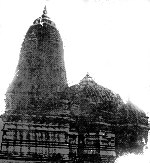|
 Introduction
Introduction
TRYANIBAKESHVAR, a religious centre of all-India fame is significant in two ways. It is the abode and one of the twelve most select abodes at that, of Shiva. Secondly, it is the source of the Godavari river, one of the two holiest watercourses of Maharashtra, the other one being Bhima. The association of the two is a very usual feature of our religious system and it is difficult to say which one enjoys greater prestige than the other. Without entering into this problem, which would by its nature be subjective, a discussion of both could be profitably undertaken. Tryam bakeshvar is situated in a small village known as Trimbak. It is some eighteen miles by road from Nasik. This is the only approach to the place. State Transport buses run to and fro constantly. During the festivals the service is increased multifold.
Trimbak stands at an easterly spur of theSahyadris. The road winds with many ups and down spast precipitous scarps of the Anjaneri ranges which continue till the semi-circular wall of hills is reached which incloses the village. The habitation of this village is comparatively recent. Only when the Peshwas devoted a great deal of attention to the shrine and the deity, did people start living here which was a wild spot before. The nearest habitation was the Anjaneri village, where the pilgrims stayed and came to the temple only for darshan and worship. During the later half of the seventeenth century, however, a large number of people made this their home and erected attractive mansions. Till recently the place exhibited somebuildings with the typical ‘Period’ facades of the Maratha times, consisting of wooden balconies with cypress pillars and cusped arches and a large amount of wood- carving. Many of these were of a high artistic standard. With the decline of the Peshwa regime the sudden spurt in the prosperity of the village slackened considerably. But the town still maintains a facade of respectability.
Author - Madhukar Shripad Mate
|